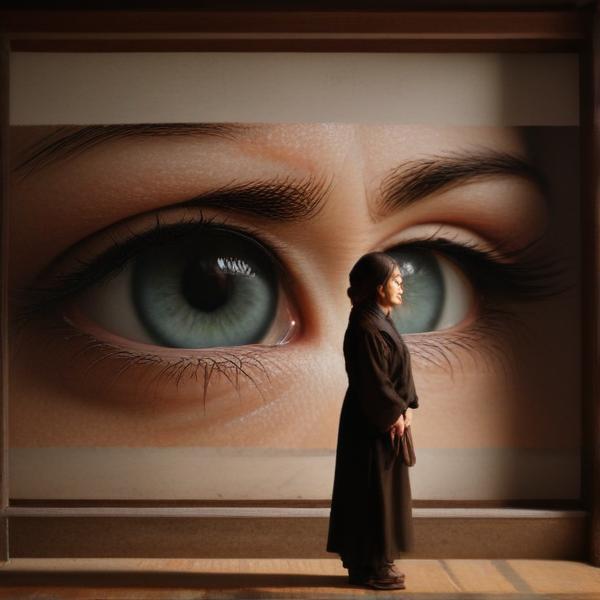基本信息 (Basic Information)
含义与用法 (Meanings & Usage)
中文核心释义 (Core Chinese Meaning): 指眼睛上方的毛发,即“眉毛”,也用于比喻,与外貌、表情相关。
英文核心释义 (Core English Meaning): eyebrow; the hair above the eyes, also used metaphorically, often related to appearance or expression.
象形意义 / 为何这么写 (Pictographic Meaning / Writing Rationale)
文言文释义 (Classical Chinese Meaning)
与现代意义相近,主要指眉毛,有时兼指美女、美人。Similar to modern meaning—primarily refers to eyebrows, sometimes used poetically for beauty or a beautiful woman.
深入学习 (In-depth Study)
字源故事 (Origin Story)
字形演变 (Character Evolution)
常用词语和例句 (Common Words & Examples)
眉毛 (eyebrow)
她有一双浓密的眉毛。
Eng: She has a pair of thick eyebrows.
眉头 (brow; the forehead area above the eyes; frowning or furrowing one's brows)
他皱起了眉头,似乎在思考什么问题。
Eng: He furrowed his brows, seeming to be deep in thought.
眉宇 (brow; space between the eyebrows, often refers to one's spirit or expression)
他的眉宇间透露出英气。
Eng: There was a heroic spirit revealed between his brows.
相关成语 (Related Idioms)
愁眉苦脸
Meaning: to wear a worried look, distressed facial expression
多语言翻译 (核心释义) (Translations (Core Meaning))
- French: sourcil
- German: Augenbraue
- Spanish: ceja
- Italian: sopracciglio
- Portuguese: sobrancelha
- Russian: бровь
- Arabic: الحاجِب
- Persian: ابرو
- Dutch: wenkbrauw
- Polish: brew
- Vietnamese: lông mày
- Ukrainian: брова
视频学习资源 (Video Learning Resources)
通过以下链接在热门视频网站搜索 "眉" 的更多讲解:
Search for more explanations of "眉" on popular video sites:
- 在 Bilibili.com 搜索 "眉 字源 说文解字" (Search on Bilibili)
- 在 YouTube.com 搜索 "眉 character origin etymology" (Search on YouTube)
网络参考 (Web References for "眉") ()
网络内容摘要 (Web Content Summary):
```html“眉”的核心含义是指眼睛上方的毛发,即“眉毛”。 The core meaning of "眉" (méi) is the hair above the eyes, that is, "eyebrow".
-
象形起源:“眉”的甲骨文在“目”(眼睛)上加折线或几根毛,象征眼上可伸展、可皱缩的毛发,体现了人的体貌特征。 Pictographic origin: In oracle bone script, "眉" is depicted by adding lines or strokes above the "eye" to represent the movable hair above the eye, symbolizing human facial features.
-
有趣的文化背景:在一些古文字中,会加“人”或“女”以突出“眉”为人的独特特征,或强调女性美丽的眉毛。 Cultural background: Some ancient scripts add the "person" or "woman" component to highlight that eyebrows are a human trait or to emphasize the beauty of women's eyebrows.
-
常见用法:“眉”常用于“眉毛”、“眉头”、“眉宇”等词,也出现在成语如“眉飞色舞”(形容高兴)、“愁眉苦脸”(形容忧愁)。 Common usage: Frequently used in words like "眉毛" (eyebrow), "眉头" (brow), and idioms such as "眉飞色舞" (radiant with joy) and "愁眉苦脸" (look worried or distressed).
-
易混淆点:“眉”与“目”同属于与眼相关的汉字,但“眉”专指毛发部分,不要与“目”(眼睛)混淆。 Potential confusion: "眉" and "目" are both related to the eye—"眉" refers specifically to the eyebrow/hair, while "目" is the eye itself; do not confuse them.
(补充:本次来源没有提供成语外更多的词汇或现代用法,信息侧重字形演变与基本含义。) (Note: Sources mainly focus on the evolution and basic meaning of the character; little detail about modern derived words was found.)
```汉字"眉"的起源、演变过程-汉字字源辞典
眉 ,甲骨文 在眼睛 上方画一道折皱线 ,表示眼睛上方可伸展可皱缩的毛发。 有的甲骨文 将折皱状 改成几根毛发形状 ,并加 " 人 " ,强调 " 眉 " 为人类的体貌特征。 有的甲骨文 将 " 人 " 写成 " 女 " ,强调女子美丽动人的眉毛。 金文 省去 " 人 " 。 有的金文 将眼上毛发 写成形状 ...
【眉】的甲骨文金文篆文字形演变含义 - 甲骨文研究网 甲骨文密码字典 在线甲骨文字典研究 - 甲骨文研究网 甲骨文密码字典 在线甲骨文字典研究 认路
附 文言版《説文解字》:眉,目上毛也。从目,象眉之形,上象頟理也。凡眉之屬皆从眉。 附 白话版《说文解字》:眉,眼睛上部的毛发。字形采用"目"作边旁,像眉毛的形状,上部褶皱像额头的皱纹。所有与眉相关的字,都采用"眉"作边旁。 文言文名句摘抄
更多图片 (眉 More Images) ()
